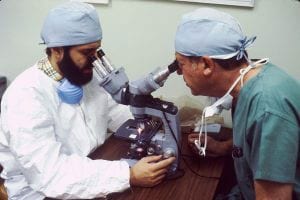According to a story from EurekAlert!, a Phase I trial is being developed that will test a unique, three part combination treatment for children with neuroblastoma, a rare form of cancer that affects children more frequently than adults. The combination includes two different types of immunotherapy combined with a specialized, targeted form of radiation therapy.
About Neuroblastoma
Neuroblastoma is a type of cancer which affects nerve tissue. In most cases it originates in the adrenal glands. However, it can also appear in the neck, spine, abdomen, or chest. The cause of this rare, pediatric cancer is poorly understood, and it appears to occur sporadically in most cases. Occasionally, it can be caused by an inherited mutation of certain genes, and some genetic disorders also increase the risk. Symptoms can vary depending on the location of the tumor, but most cases present with joint pain, fatigue, loss of appetite, and fever. Treatment may include surgery, chemotherapy, radiation therapy, and stem cell transplant. Tumors that have not spread may be curable. Younger patients generally have more favorable outcomes. The five year survival rate in the US for patients age 1-14 is 68 percent. To learn more about neuroblastoma, click here.
The Triple Threat
There is a serious need for more effective treatment options for neuroblastoma, as nearly 50 percent of patients with disease classified as high risk do not respond sufficiently to current treatment approaches. One form of immunotherapy that will be used in the trial is called anti-GD2. This form of immunotherapy uses antibodies to target tumor cells for destruction by the immune system. This treatment is already in use for neuroblastoma, but some patients still relapse after treatment with it.
The other type of immunotherapy that will be used is called nivolumab, which is classified as a checkpoint inhibitor. In effect, this therapy blocks a signal that would normally prevent T-cells from attacking cancer cells. Blocking this signal allows T-cells to recognize tumors as a foreign target that should be attacked. This drug has already been approved as a treatment for a number of other types of cancer.
The radiation therapy that will be used in the trial is called mIBG, which delivers iodine, a radioactive substance, directly to neuroblastoma cells. Hopefully, this combination of therapies will prove to be a potent trifecta against this childhood cancer.







